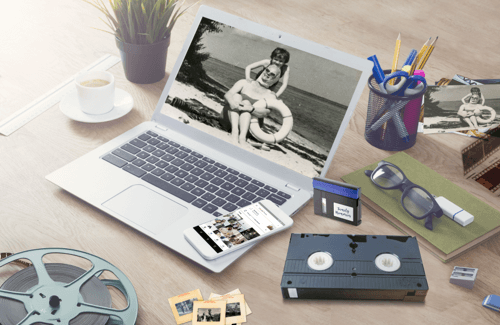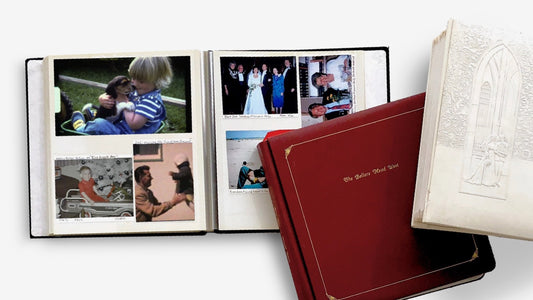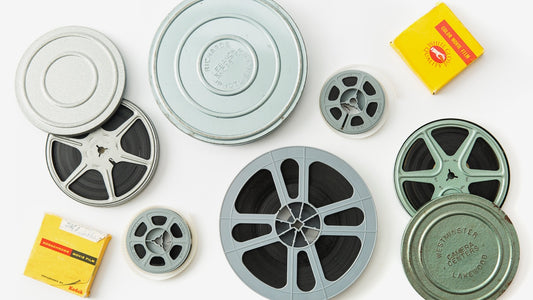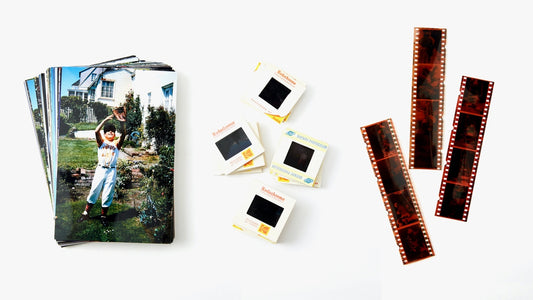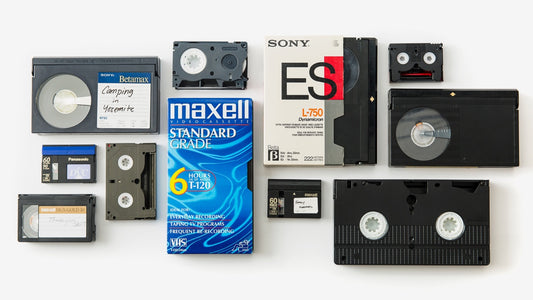Every old photograph tells a story, but a black-and-white image can sometimes feel like it’s missing a few chapters. You see the faces and the places, but the full emotion of the moment can feel distant. What color was your grandmother’s wedding bouquet? What did that first family car really look like? The act of restoring color in old photos fills in those missing details, adding a layer of context and feeling that makes the story complete. It transforms a historical record into a vivid memory, allowing you and your family to connect with your past in a much more personal way.
Key Takeaways
- Choose Your Path: DIY Fun or Professional Polish: For casual snapshots, user-friendly AI tools offer a quick and rewarding way to add color. But for truly precious or heavily damaged photos, investing in a professional service ensures a high-quality, authentic restoration that honors the memory.
- Start with a Quality Scan and Edit in Layers: The foundation of any great restoration is a high-resolution digital copy. From there, always make your edits on separate layers to protect the original scan, giving you the freedom to experiment with color and repairs without risk.
- Protect Your Restored Memories for the Future: Once your photo is restored, save a master copy as a lossless file like TIFF or PNG. Create a reliable backup system using both cloud storage and a physical drive to ensure your family’s visual history is safe and accessible for generations.
Why Restore Color in Old Photos?
Have you ever stumbled upon an old family photo and wished you could see it in full color? There’s something truly magical about seeing the past come alive with the same vibrancy we experience in our daily lives. Restoring color in old photos does more than just make them look pretty; it breathes new life into them, closing the gap between generations and making history feel personal. It turns a distant, black-and-white ancestor into a relative you can almost recognize, with rosy cheeks and familiar-colored eyes.
Color adds depth, emotion, and a sense of reality that monochrome images sometimes lack. It helps us connect more deeply with the people and places in the pictures, making their stories feel more immediate and relatable. Whether you're looking to repair a faded snapshot from the 80s or colorize a portrait from the 1880s, the goal is the same: to preserve a precious moment and make it accessible for your family to enjoy for years to come. Thanks to modern technology, this process is easier than ever, allowing you to restore your family’s visual history and keep those memories from fading away.
What Makes a Colorized Photo So Special?
Colorizing a black-and-white photo feels like opening a window to the past. Suddenly, a flat, historical image is filled with life and context. You can see the true color of your grandmother’s wedding dress or the brilliant green of the family’s first car. This added layer of detail makes the moment feel more real and helps you connect with the subjects on a more personal level. Advanced AI tools can now add surprisingly realistic and vibrant colors to old photos, transforming them from historical artifacts into vivid family memories. The first step in this transformation is creating a high-quality digital copy through a professional photo transfer service, which sets the foundation for a beautiful restoration.
Common Problems with Faded Photos
Over the years, physical photos face a lot of enemies: light, humidity, and simply the passage of time. You’ve probably seen the common signs of aging in your own collection. Many older color photos develop a yellow or reddish tint, while others just look washed out. Physical damage is also a frequent issue. Thankfully, most of these problems can be fixed. Skilled restoration can repair everything from minor scratches and fading to more serious issues like tears, water damage, and even missing pieces. Whether you're dealing with a discolored print from a sticky old photo album or a picture that’s been folded one too many times, there’s a good chance it can be brought back to its former glory.
Connecting with Your Family's Past
Restoring old photos is a powerful way to keep your family's history alive. When you share a newly colorized photo of a great-grandparent, you’re not just sharing an image; you’re sharing a piece of your heritage. It gives younger generations a tangible connection to the people who came before them and can spark wonderful conversations and storytelling. Once a photo is restored and saved digitally, it’s protected from the physical damage that can ruin original prints. Creating a digital archive of your family’s pictures ensures these precious moments are preserved forever. Services that handle album scanning can help you safely digitize entire collections, protecting your family’s legacy for the future.
How to Choose Your Restoration Method
Deciding how to bring color back to your old photos is a big step. The path you choose depends on a few key things: your budget, how much time you have, your comfort level with technology, and most importantly, how precious the photograph is to you. There’s no single right answer—it’s about finding the perfect fit for your family’s memories.
If you’re working with a one-of-a-kind photo of your great-grandparents, you’ll likely want a different approach than you would for a shoebox full of faded snapshots from a family vacation. Think about the story behind the photo and what you hope to achieve. Are you looking for a quick, colorful update to share on social media, or do you need a museum-quality restoration that honors the original moment? Let's break down the main options—doing it yourself versus hiring a professional—so you can make a choice you feel great about.
Should You Hire a Pro or Do It Yourself?
Going the DIY route can be a rewarding project if you enjoy creative tasks and have the time to learn new software. It’s a great option for photos that aren’t heavily damaged or for when you want to experiment without the pressure of perfecting an irreplaceable image. You get full creative control and the satisfaction of bringing a memory back to life with your own hands.
On the other hand, for those truly priceless photos, hiring a professional is often the best decision. Experts have the technical skill and artistic eye to handle severe damage like tears, stains, and extreme fading. Professional services often involve detailed manual work and offer revisions to ensure you’re happy with the result. This gives you peace of mind knowing your most cherished memories are in capable hands, ensuring a high-quality photo transfer that will last for generations.
AI Tools vs. Manual Editing: What's the Difference?
The world of photo restoration is split between two main techniques: automated AI tools and hands-on manual editing. AI-powered tools are often web-based and incredibly fast, using algorithms to automatically colorize and repair photos with just a few clicks. They’re fantastic for quick fixes and are generally user-friendly, requiring no special editing skills.
Manual editing, however, is an art form. This is what professionals do, using sophisticated software like Adobe Photoshop to meticulously restore every detail by hand. While AI can sometimes miss the mark on historical accuracy or skin tones, a human expert provides a personal touch and nuance that technology can’t yet match. This hands-on approach allows for greater precision, ensuring the final image feels authentic and emotionally resonant, which is especially important when you’re preserving entire photo albums.
Comparing Costs: What to Expect
Your budget will play a big role in your decision. DIY restoration can be very affordable, with some online AI tools available for free or for a small fee. If you want more control, you might invest in a software subscription, but your main cost will be your time.
Professional restoration services have a wider price range. You might find freelancers online offering to restore a photo for just a few dollars, but these often rely solely on basic AI tools and may not deliver the quality you’re hoping for. Reputable restoration companies typically charge anywhere from $30 to over $500 per photo, depending on the level of damage. This higher price reflects the expert, manual labor required to carefully and accurately restore your image to its former glory.
Working with a Professional Restoration Service
If your photos are more than just a little faded—think tears, water damage, or significant discoloration—handing them over to a professional is often the best path forward. While DIY tools are impressive, they can’t always replicate the nuanced work of a trained technician. A professional service combines powerful software with a human touch, ensuring your restored images look authentic and not overly processed. It’s an investment in getting the job done right, especially for those one-of-a-kind photos that mean the world to you. Entrusting your memories to an expert not only saves you time and potential frustration but also gives you peace of mind knowing they’re in capable hands.
How to Find the Right Service
When you start looking for a restoration service, you’ll find a wide range of options, from cheap freelancers to established companies. For your most treasured photos, it’s worth seeking out a professional company. Many low-cost freelancers simply run your photo through a basic AI filter, which might not deliver the quality you’re hoping for. A dedicated service, on the other hand, typically involves manual work by skilled artists who can make detailed edits and offer revisions. Look for a service that showcases a portfolio of before-and-after examples and has clear, positive customer reviews. This transparency helps you gauge the quality of their work and find a partner you can trust with your family’s history.
A Look at YesVideo's Restoration Process
At YesVideo, we treat every photo with the care it deserves. The restoration journey begins by creating a high-quality digital copy of your original print through our professional photo transfer service. Once your image is digitized, our US-based technicians get to work. Using advanced editing software, they manually address issues like scratches, fading, tears, and discoloration. This hands-on approach allows us to make thoughtful corrections that honor the original photo, from restoring realistic skin tones to fixing distracting imperfections. We combine technology with artistry to ensure the final result is a beautifully restored image that your family can cherish for generations to come.
Understanding Service and Pricing Options
The cost of professional photo restoration can vary quite a bit, and it usually comes down to the extent of the damage. A simple color correction on a faded photo will naturally cost less than repairing an image with deep cracks, missing pieces, or severe water stains. While some freelancers might offer to fix a photo for as little as $5, professional companies typically charge between $30 and $500 per image. This price reflects the technician’s time, skill, and the sophisticated tools required for detailed manual work. Think of it as commissioning a small piece of art—the investment ensures your precious memory is restored with the attention and expertise it needs.
The Best Tools for Photo Restoration
If you're ready to try restoring photos yourself, you'll find a wide range of tools available, from simple AI-powered apps to professional-grade software. The right choice depends on the condition of your photos, your budget, and how much time you want to spend on the project. Some tools offer quick, automated fixes, while others give you complete creative control over every detail. Let's look at some of the most popular options to help you find the perfect fit for bringing your cherished memories back to life.
Top AI-Powered Restoration Tools
For a quick and surprisingly effective fix, AI-powered tools are a fantastic starting point. These apps use artificial intelligence to automatically colorize black-and-white photos, correct fading, and even repair minor damage. A great example is Image Colorizer, an online tool that can add realistic color to your old pictures in just a few minutes. Another popular option is PhotoGlory, a user-friendly program that helps you fix faded colors and offers both automatic and manual colorization. These tools are perfect if you’re not a photo editing expert but want to see your old photos in a new light without a steep learning curve.
Go-To Professional Editing Software
If you’re looking for more control and professional-quality results, Adobe Photoshop is the industry standard for a reason. It’s a powerful tool that can handle everything from simple color correction to complex repairs of severely damaged photos. While it might seem intimidating, Photoshop has features designed to make the process easier. The Photo Restoration Neural Filter, for instance, uses AI to improve old photos with just a few clicks. For those who want to dive deep into editing, Photoshop offers the precision needed to get every detail just right, making it the top choice for serious restoration projects.
Key Features to Look For
When comparing different restoration tools, there are a few key features that can make a huge difference. Look for automatic colorization to instantly add life to black-and-white images. Damage repair tools are also essential—many programs, like PhotoGlory, offer brushes that can remove scratches, tears, and fingerprints. You’ll also want color correction sliders to adjust brightness, contrast, and saturation for a more natural look. Some tools even offer batch processing, which allows you to apply the same fixes to multiple photos at once, saving you a ton of time.
How Different Tools Are Priced
The cost of photo restoration can vary widely. Many AI-powered tools offer free versions with basic features, with subscriptions or one-time fees for more advanced capabilities. Professional software like Adobe Photoshop typically requires a monthly subscription. If you decide to hire a professional service, prices can range from around $30 for simple touch-ups to over $500 for extensive restoration on a single photo. Weighing the cost of tools and your time against hiring an expert can help you decide which path is best for preserving your precious memories.
Learn Key Color Restoration Techniques
Once you have a digital copy of your photo, you can start the exciting process of bringing its colors back to life. Whether you're using sophisticated software or a simple AI tool, a few key techniques will help you get the best results. Think of it as part art, part science—a way to carefully repaint the past. The goal is to make the photo look vibrant and authentic, just as you remember it.
These methods will give you a solid foundation for correcting colors and fixing common issues. With a little practice, you’ll be able to breathe new life into your family’s oldest and most treasured pictures.
Your First Steps in Color Correction
Color correction is the first thing you’ll do to improve your photo. The idea is to fix issues like fading, discoloration, scratches, and tears to make the image look new again. Before you add or adjust any colors, you need a clean digital canvas to work on. This process starts with a high-quality scan of your original picture, which you can get done professionally through a photo transfer service.
Once you have your digital file, open it in your chosen editing software. Start with basic adjustments. Tweak the brightness to make sure the image isn't too dark or washed out. Adjust the contrast to bring back some definition between the light and dark areas. These simple changes can make a huge difference right away.
How to Get Natural-Looking Skin Tones
Getting skin tones right is one of the trickiest parts of color restoration, but it’s what makes a portrait feel truly alive. The key is to remember that skin isn't just one flat color; it’s a complex mix of reds, yellows, and other tones. To make the restored photo look real, try to keep some of the natural skin texture and minor imperfections. A perfectly smooth, airbrushed look can often feel artificial.
If you have other color photos of the same person, use them as a reference. Pay attention to the subtle shifts in color on different parts of the face. When adjusting, work with the red and yellow channels in your editing tool. Small, careful adjustments are better than drastic changes. The goal is to create a warm, believable complexion that honors the person in the photo.
Tips for Historically Accurate Colors
To make your restored photo feel authentic, the colors should match the era it came from. The vibrant hues of a 1980s photo are very different from the muted, warm tones of a picture from the 1960s. Do a little research on the time period. Look up photos from that decade to get a feel for the common color palettes in clothing, cars, and home decor.
When you begin colorizing a black-and-white image, you can use simple photo editing techniques to get high-quality results. Start with subtle colors and build them up slowly. Overly bright, saturated colors can make a vintage photo look modern and out of place. A softer, more delicate approach often yields a more believable and timeless result.
How to Handle Different Types of Photos
Not all old photos are the same, and your approach will change depending on what you’re working with. For black-and-white photos, you are essentially adding color from scratch. Some tools can automatically add colors, which gives you a great starting point that you can then refine yourself.
For sepia photos, you’ll first need to neutralize the brown tint before adding new colors. If you’re working with a faded color photo, your job is to restore the original colors, not invent new ones. This usually involves increasing saturation and correcting any color casts. For example, many old photos develop a yellow or magenta tint over time, which you can balance out in your editing software.
Solve Common Restoration Problems
Old photos often come with physical damage like scratches, dust, tears, or water spots. Before you perfect the color, you’ll want to repair this damage digitally. Most professional editing programs, like Photoshop, have tools specifically for this. The "Clone Stamp" and "Healing Brush" are two of the most useful for these kinds of repairs.
These tools allow you to copy a clean, undamaged part of the photo and paint over the flawed area. For a small scratch, you can sample the area right next to it to seamlessly cover the mark. This step can be time-consuming, especially on a heavily damaged photo, but it’s essential for a clean, polished final image. Taking the time to fix these imperfections will make your color work stand out even more.
Pro Tips for a Flawless Finish
Once you’ve chosen your tools, a few key techniques can make a world of difference in your final result. Think of these as the finishing touches that separate a good restoration from a great one. Whether you're using a simple AI tool or diving into professional software like Photoshop, these tips will help you achieve a polished, natural-looking photo that truly honors the original memory. It’s all about working smart, not just hard.
By focusing on a quality starting point and using a gentle touch, you can avoid common pitfalls that make restored photos look artificial or over-edited. The goal is to bring the image back to life, not create something entirely new. These professional habits will help you correct colors, fix imperfections, and preserve the authentic feel of your cherished family pictures. Let’s walk through the simple steps that will give your project that flawless finish.
Start with a High-Quality Scan
Every great photo restoration begins with a great digital copy. If your starting image is blurry or low-resolution, your final result will be, too. As the experts at Great Big Photography World note, "First, you need to make a high-quality digital copy of the old photo, usually with a flatbed scanner." A scanner captures far more detail than just taking a picture of a photo with your phone. For the best results, scan your photos at a resolution of at least 600 DPI (dots per inch).
If you don't have a scanner at home, don't worry. Using a professional service ensures you get a high-resolution digital file that’s perfect for restoration. A professional photo transfer service handles this for you, giving you the best possible foundation to work from.
Understand the Basics of Color Balance
Faded photos often have a color cast, like a yellow or reddish tint that washes everything out. Correcting this is one of the most important steps. Most editing software has tools to adjust the color balance. In Photoshop, for example, you can "use the 'Hue/Saturation adjustment layer' to change the intensity and type of colors," according to Adobe.
A simple trick is to find an area in the photo that should be neutral white or gray—like a white shirt or a sidewalk. Use your software’s color balance tool to click on that spot and tell it, "This should be neutral." This often corrects the color cast across the entire image, giving you a much more natural-looking starting point for further edits.
Edit Safely with Non-Destructive Methods
It can be scary to make permanent changes to a precious family photo, even a digital copy. That’s why professionals use non-destructive editing. This just means you make your changes on separate layers instead of directly on the original image file. As Adobe explains, "It's important to work on new layers in Photoshop so you don't change your original photo."
Think of it like placing a clear sheet over your photo and drawing on that instead of the photo itself. If you make a mistake or don’t like a change, you can just erase that layer or delete it without ever harming your original scan. This gives you the freedom to experiment with colors and repairs until you get them just right.
How to Fine-Tune the Small Details
The secret to a truly convincing restoration is in the details. After you’ve made your big color corrections, zoom in on the photo to look for small imperfections like dust, scratches, or tiny stains. When you’re fixing these spots with tools like a healing brush or clone stamp, it’s best to "use small strokes instead of painting over large areas," as Adobe suggests. This approach helps your fixes blend in seamlessly and look more natural.
Take your time with this step. Working on small sections one at a time is much more effective than trying to fix everything at once. Patience here will pay off, leaving you with a clean, beautiful photo that looks like it was taken yesterday.
How to Preserve Your Restored Photos
You’ve put so much care into bringing an old photo back to life. The colors are vibrant, the details are sharp, and the memory feels as fresh as the day it was captured. Now, the final and most important step is to make sure that restored image is protected for generations to come. Saving your work correctly and creating a smart storage plan ensures your family’s history won’t be lost to a hard drive failure or an accidental deletion. It’s all about creating a digital archive that is safe, secure, and easy for your whole family to access and enjoy.
Choose the Right File Format and Resolution
When you save your restored photo, the file format you choose makes a big difference. For archival purposes, always save your master copy as a TIFF or PNG file. These are “lossless” formats, which means they preserve every single pixel of data without any quality loss, keeping your restoration work pristine. Think of it as the digital negative. For sharing online or via email, a JPEG is perfectly fine. JPEGs are smaller and easier to send, but they are “lossy,” meaning some quality is sacrificed to reduce the file size. Always work from your TIFF or PNG master file when you need to create a new JPEG for sharing.
Find the Best Digital Storage Options
The best way to store your precious photos is to use a combination of cloud and local storage. Cloud services like Dropbox, Google Photos, or iCloud are fantastic because they back up your photos automatically and let you access them from any device, anywhere. You can easily store your photos in the cloud and not worry about a computer crash wiping them out. At the same time, it’s wise to keep a local copy on an external hard drive or a high-capacity USB drive. This gives you a physical backup that you control completely, ensuring you have access to your files even without an internet connection.
Why You Need a Backup System
Having just one copy of your restored photos is a recipe for heartbreak. Technology can fail, and accidents happen. A solid backup system is your only true safeguard. Many experts recommend a 3-2-1 strategy: keep at least three copies of your photos, store them on two different types of media (like your computer and an external hard drive), and keep one copy off-site. Your cloud storage account is the perfect off-site backup. This redundancy ensures that even if one backup fails, you have others to fall back on. The best way to back up photos is one that is consistent and combines both physical and online storage.
Easy Ways to Share Your Restored Photos
The joy of restoring old photos is in sharing them with the people you love. Cloud storage makes this incredibly simple. You can create a shared album and send a link to your family, allowing everyone to view, download, and comment on the images. This is a wonderful way to reconnect with relatives and piece together the stories behind the photos. You can also use these high-quality digital files to create beautiful prints, custom photo books, or even canvas art to display in your home. After all, these memories were meant to be seen and celebrated, not just stored on a drive.
A Quick Guide to Best Practices
Getting a great result when you restore photos comes down to a few key practices. Whether you're using a simple AI tool or diving into professional software, keeping these tips in mind will help you create a beautifully colorized image that feels authentic and true to the original moment. Think of these as your foundational steps for any color restoration project. They’ll give you more control over the final look and help you avoid common mistakes, ensuring your precious memories are handled with care.
Use Reference Photos for Accuracy
When you’re trying to bring a black-and-white photo to life, guessing colors can lead to an image that feels unnatural. That's where reference photos come in. If you have other color photos from the same time period or of the same people, use them as your guide. Pay attention to things like hair color, eye color, and the typical shades of clothing from that era. This simple step helps you make informed choices and adds a layer of historical accuracy to your work, making the final photo much more believable and emotionally resonant.
Work with Layers for Better Control
One of the best habits you can develop is working with layers. Think of layers as transparent sheets you place over your original photo. You can add color and make adjustments on these sheets without ever changing the original image file underneath. This is called non-destructive editing, and it’s a lifesaver. It gives you the freedom to experiment with different colors and effects. If you don’t like something, you can just delete the layer and start again without any risk to your precious original scan. Most photo editing software is built around this powerful feature.
Learn Simple Color Blending Methods
Getting the color you’ve added to look like it’s truly part of the photo is all about blending. You don’t want colors to look like they’re just sitting on top of the image. Photo editing programs have tools that help you blend your colors smoothly. You can adjust the transparency of your color layers to make the effect more subtle or use different blending modes to change how the color interacts with the tones of the original photo. Playing with these settings will help you achieve a much more seamless and professional-looking result.
Do a Final Quality Check
Once you think you’re finished, take a break. Step away from the screen for a little while and come back with fresh eyes. Look over the entire image. Are the skin tones consistent? Are there any spots where color has bled outside the lines? Does the overall picture feel balanced? This final review is your chance to catch small mistakes and make those last little tweaks. Once you’re happy with it, you can save your restored masterpiece. Then you’ll be ready to share your digital photos with family and friends.
Related Articles
- The Ultimate Photo Digitizing Service Guide – YesVideo
- Digitize Photos: The Ultimate Guide for 2024 – YesVideo
Frequently Asked Questions
What if my photo is really badly damaged, like torn or water-stained? Can it still be saved? It’s amazing what can be fixed with modern restoration. Even photos with significant damage like tears, deep creases, water spots, or missing corners can often be brought back to life. Professional technicians use advanced software to digitally repair these imperfections, meticulously reconstructing damaged areas. While every photo is different, you’d be surprised how many seemingly hopeless images can be beautifully restored.
I'm not very tech-savvy. Is it realistic for me to try restoring photos myself? If you're curious, you can certainly try! Start with a user-friendly AI tool and a photo that isn't a one-of-a-kind heirloom. This lets you experiment without any pressure. However, for your most precious or severely damaged photos, hiring a professional is often the best choice. It saves you the learning curve and ensures your memory is handled by an expert with the right skills and tools for the job.
How do I make sure the colors in the restored photo look authentic and not like a cartoon? This is a great question, as the goal is realism, not just color. The key is to use a subtle touch. If you have other color photos from that time period, use them as a reference for clothing and background colors. Pay close attention to getting skin tones right, as this is what makes a portrait feel real. It’s always better to build up color slowly rather than starting with overly bright, saturated shades that can make a vintage photo look artificial.
What's the single most important thing I can do to get a good result? Start with a high-quality scan of your original photo. A clear, high-resolution digital file is the foundation for everything that follows. Scanning at 600 DPI or higher captures the fine details and textures needed for a great restoration. If you try to work from a blurry or low-quality image, your final result will be limited, no matter how skilled you are or how great your software is.
I have a whole box of old photos. Should I restore all of them? That would be a huge project! A more practical approach is to start by getting the entire collection digitized first. This protects all your photos from further physical aging. Once they are safely scanned, you can go through the digital files and pick a few of your most meaningful photos to restore—perhaps a wedding portrait, a multi-generational family picture, or a favorite candid shot. You can always restore more later.





